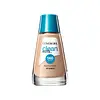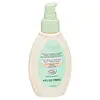What's inside
What's inside
 Key Ingredients
Key Ingredients

 Benefits
Benefits

 Concerns
Concerns

 Ingredients Side-by-side
Ingredients Side-by-side

Water
Skin ConditioningCyclopentasiloxane
EmollientPropylene Glycol
HumectantTalc
AbrasiveGlycerin
HumectantPEG/PPG-18/18 Dimethicone
EmulsifyingCetyl Ethylhexanoate
EmollientCyclomethicone
EmollientMagnesium Sulfate
Silica
AbrasiveLaureth-7
EmulsifyingArachidyl Behenate
EmollientSodium Dehydroacetate
PreservativeTrihydroxystearin
Skin ConditioningPropylparaben
PreservativeMethicone
EmollientIsopropyl Titanium Triisostearate
EmollientMethylparaben
PreservativeSynthetic Wax
AbrasiveTrisodium EDTA
Ethylene Brassylate
MaskingStearic Acid
CleansingTitanium Dioxide
Cosmetic ColorantIron Oxides
Mica
Cosmetic ColorantWater, Cyclopentasiloxane, Propylene Glycol, Talc, Glycerin, PEG/PPG-18/18 Dimethicone, Cetyl Ethylhexanoate, Cyclomethicone, Magnesium Sulfate, Silica, Laureth-7, Arachidyl Behenate, Sodium Dehydroacetate, Trihydroxystearin, Propylparaben, Methicone, Isopropyl Titanium Triisostearate, Methylparaben, Synthetic Wax, Trisodium EDTA, Ethylene Brassylate, Stearic Acid, Titanium Dioxide, Iron Oxides, Mica
Water
Skin ConditioningC12-15 Alkyl Benzoate
AntimicrobialCetearyl Alcohol
EmollientGlycerin
HumectantDimethicone
EmollientGlycine Soja Seed Extract
Skin ConditioningBis-Phenylpropyl Dimethicone
Arachidyl Alcohol
EmollientCetearyl Glucoside
EmulsifyingBenzyl Alcohol
PerfumingPanthenol
Skin ConditioningEthylene/Acrylic Acid Copolymer
Emulsion StabilisingBehenyl Alcohol
EmollientSteareth-2
EmulsifyingParfum
MaskingSteareth-21
CleansingPolymethyl Methacrylate
Polyacrylamide
Arachidyl Glucoside
EmulsifyingDisodium EDTA
C13-14 Isoparaffin
EmollientLaureth-7
EmulsifyingSilica
AbrasiveChlorphenesin
AntimicrobialBHT
AntioxidantTitanium Dioxide
Cosmetic ColorantMica
Cosmetic ColorantEthylhexyl Salicylate
UV AbsorberButyl Methoxydibenzoylmethane
UV AbsorberEthylhexyl Methoxycinnamate
UV AbsorberWater, C12-15 Alkyl Benzoate, Cetearyl Alcohol, Glycerin, Dimethicone, Glycine Soja Seed Extract, Bis-Phenylpropyl Dimethicone, Arachidyl Alcohol, Cetearyl Glucoside, Benzyl Alcohol, Panthenol, Ethylene/Acrylic Acid Copolymer, Behenyl Alcohol, Steareth-2, Parfum, Steareth-21, Polymethyl Methacrylate, Polyacrylamide, Arachidyl Glucoside, Disodium EDTA, C13-14 Isoparaffin, Laureth-7, Silica, Chlorphenesin, BHT, Titanium Dioxide, Mica, Ethylhexyl Salicylate, Butyl Methoxydibenzoylmethane, Ethylhexyl Methoxycinnamate
Ingredients Explained
These ingredients are found in both products.
Ingredients higher up in an ingredient list are typically present in a larger amount.
Glycerin is already naturally found in your skin. It helps moisturize and protect your skin.
A study from 2016 found glycerin to be more effective as a humectant than AHAs and hyaluronic acid.
As a humectant, it helps the skin stay hydrated by pulling moisture to your skin. The low molecular weight of glycerin allows it to pull moisture into the deeper layers of your skin.
Hydrated skin improves your skin barrier; Your skin barrier helps protect against irritants and bacteria.
Glycerin has also been found to have antimicrobial and antiviral properties. Due to these properties, glycerin is often used in wound and burn treatments.
In cosmetics, glycerin is usually derived from plants such as soybean or palm. However, it can also be sourced from animals, such as tallow or animal fat.
This ingredient is organic, colorless, odorless, and non-toxic.
Glycerin is the name for this ingredient in American English. British English uses Glycerol/Glycerine.
Learn more about GlycerinLaureth-7 is created by the ethoxylation of lauryl alcohol using ethylene oxide. Lauryl alcohol is a fatty alcohol with hydrating properties.
This ingredient is an emulsifier and cleansing ingredient. As an emulsifier, it is used to prevent ingredients from separating. It also helps cleanse the skin by gathering dirt, oil, and pollutants to be rinsed away.
Mica is a naturally occurring mineral used to add shimmer and color in cosmetics. It can also help improve the texture of a product or give it an opaque, white/silver color.
Serecite is the name for very fine but ragged grains of mica.
This ingredient is often coated with metal oxides like titanium dioxide. Trace amounts of heavy metals may be found in mica, but these metals are not harmful in our personal products.
Mica has been used since prehistoric times throughout the world. Ancient Egyptian, Indian, Greek, Roman, Aztec, and Chinese civilizations have used mica.
Learn more about MicaSilica, also known as silicon dioxide, is a naturally occurring mineral. It is used as a fine, spherical, and porous powder in cosmetics.
Though it has exfoliant properties, the function of silica varies depending on the product.
The unique structure of silica enhances the spreadability and adds smoothness, making it a great texture enhancer.
It is also used as an active carrier, emulsifier, and mattifier due to its ability to absorb excess oil.
In some products, tiny microneedles called spicules are made from silica or hydrolyzed sponge. When you rub them in, they lightly polish away dead skin layers and enhance the penetration of active ingredients.
Learn more about SilicaTitanium dioxide is a mineral UV filter widely used in sunscreens and cosmetics.
It is one of only two UV filters officially classified as “mineral” by regulatory agencies, the other being zinc oxide.
Titanium dioxide provides broad-spectrum protection mostly in the UVB and UVAII range, with some protection in the UVAI range.
While its UVA protection isn’t as strong as zinc oxide’s, the difference is minor.
A common myth is that mineral UV filters reflect UV light. However, modern research shows titanium dioxide absorbs UV radiation like chemical filters (~95% absorption & 5% reflection).
Thanks to its non-irritating nature, titanium dioxide is suitable for sensitive, acne-prone, or redness-prone skin. It is unlikely to cause "eye sting" like other sunscreen ingredients.
A major drawback of this ingredient is its white cast and thick texture. This is why mineral sunscreens often leave a white cast and are less cosmetically elegant than chemical/hybrid sunscreens.
To improve white cast and spreadability, micronized or nano-sized titanium dioxide is often used.
There are ongoing concerns surrounding nano-titanium oxide's impact on marine ecosystems.
There is no conclusive evidence that any form of titanium oxide (or any other sunscreen ingredients) will cause harm to marine ecosystems or coral reefs. The science is still developing but many consumers are keeping a close eye on this issue.
Please note, many destinations have reef-safety sunscreen rules. For instance, the U.S. Virgin Islands advises all visitors to use non-nano mineral sunscreens.
Nano mineral sunscreens once raised safety concerns about absorption into skin.
Extensive research has shown that they do not penetrate healthy or damaged skin; they remain safely on the surface and the top layer of dead skin (stratum corneum).
You'll likely find titanium dioxide bundled with alumina, silica, or dimethicone. These ingredients help make titanium dioxide highly photostable; this prevents it from interacting with other formula components under UV light.
Learn more about Titanium DioxideWater. It's the most common cosmetic ingredient of all. You'll usually see it at the top of ingredient lists, meaning that it makes up the largest part of the product.
So why is it so popular? Water most often acts as a solvent - this means that it helps dissolve other ingredients into the formulation.
You'll also recognize water as that liquid we all need to stay alive. If you see this, drink a glass of water. Stay hydrated!
Learn more about Water